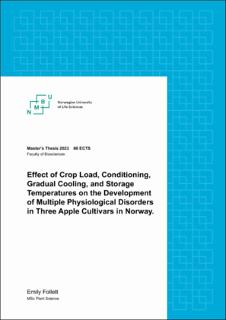| dc.description.abstract | Reducing food waste and post-harvest losses by minimizing physiological disorders is of importance worldwide and in Norway, especially in apple (Malus domestica Borkh). The main cultivar grown in Norway, ‘Red Aroma’, is susceptible to soft scald, a chilling injury, in storage. Soft scald is often controlled by storing fruit of sensitive cultivars in storage temperatures at or above 3°C, in addition to gradual cooling or conditioning. While soft scald is primarily affected by storage temperature, there are other factors that may affect incidence, including fruit size, and crop load. In this experiment, regulating crop loads were used as a way to ensure different fruit sizes and examine their effect on soft scald incidence. Two cultivars, ‘Eden’ and ‘Fryd’, were recently bred for the Norwegian market. Both cultivars have ‘Honeycrisp’ as a parent, which is susceptible to many physiological disorders, including soft scald. Determining if ‘Eden’ and ‘Fryd’ was susceptible to soft scald or other physiological disorders was therefore examined in a range of storage temperatures.
To obtain different fruit sizes, ‘Red Aroma’ trees were thinned to low, medium, or high crop loads and monitored throughout the season. Fruit were harvested at commercial harvest and exposed to 1 or 4°C. Separately, fruit from the three cultivars were exposed to six different temperature regimes for a gradual cooling experiment. Fruit were either placed in 7°C and temperatures were lowered by 1°C each day until they reached 1, 2, or 4°C, or placed directly at those three temperatures. Simultaneously, ‘Eden’ and ‘Fryd’ fruit were picked for a conditioning experiment and placed in six temperature regimes. Fruit were placed in 10 or 20°C and temperatures remained constant for one week before fruit were moved to 1 or 4°C, or fruit were placed directly in 1 or 4°C. All fruit were stored in regular atmosphere for nine or ten weeks, followed by a shelf-life period for 14 days at 20°C. Fruit quality (background color, firmness, soluble solids concentration, titratable acidity, and starch index) was monitored throughout storage, and fruit were assessed for physiological damage and fungal decay at the end of the shelf-life period.
Low crop load ‘Red Aroma’ fruit were largest throughout most of the growing season and at harvest. Unexpectedly, they were less mature at harvest than medium or high crop load fruit. However, fruit quality was overall similar for all three crop loads after cold storage and the shelf-life period. After the shelf-life period, no differences were found in soft scald incidence between crop loads. The differences in crop loads or fruit sizes may not have been great enough to influence soft scald susceptibility. Regardless of crop load, fruit stored in 1°C had more soft scald than fruit stored in 4°C. This was also true of the ‘Red Aroma’ fruit from the gradual cooling experiment, where fruit stored in 4°C or gradually cooled from 7 to 4°C had less soft scald and similar fruit quality compared to all other temperature regimes. However, regardless of temperature regime, all fruit in the gradual cooling experiment had unmarketable firmness after nine weeks of cold storage, suggesting that short storage durations, harvesting at earlier maturities, and storage in 4°C or gradual cooling to 4°C may result in lower post-harvest losses in ‘Red Aroma’ fruit.
In contrast, ‘Eden’ and ‘Fryd’ fruit both maintained high fruit quality throughout cold storage, yet both cultivars were susceptible to multiple physiological disorders. Soft scald was not found in ‘Eden’ fruit and was only present in ‘Fryd’ fruit when conditioned at 20°C and stored at 1°C. Watercore was found in ‘Eden’ fruit at harvest and throughout storage and was not completely dissipated after the shelf-life period. Core browning was the most commonly found disorder in both cultivars. In ‘Eden’, core browning was minimized by storage at 1 or 2°C, with or without gradual cooling. Conditioning at either 1 or 4°C increased core browning incidence compared to direct storage. However, in ‘Fryd’, core browning was best controlled by storage at 4°C with conditioning or gradual cooling, although unacceptable amounts of core browning were found in each temperature regime. Other disorders, such as greasiness, bitter pit, and diffuse flesh browning were also found, but in small amounts. Fungal decay was limited in all experiments and unaffected by any treatment. In summary, physiological disorders, especially core browning, in ‘Eden’ and ‘Fryd’ and soft scald in ‘Red Aroma’ may have been caused by a variety of pre- and post-harvest factors and should be studied over multiple seasons, tree ages, locations, crop loads, and maturities at harvest. | |
